Sweet ![]() Marie Kondo is quietly taking over the world one closet at a time, and you’ll want yours to be next!
Marie Kondo is quietly taking over the world one closet at a time, and you’ll want yours to be next!
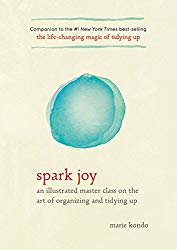 With The Life-Changing Magic of Tidying Up: The Japanese Art of Decluttering and Organizing released in English in 2014 and her new Spark Joy: An Illustrated Master Class on the Art of Organizing and Tidying Up, this Japanese powerhouse is taking minimalism to the masses and teaching us to love our stuff, ourselves, and the process.
With The Life-Changing Magic of Tidying Up: The Japanese Art of Decluttering and Organizing released in English in 2014 and her new Spark Joy: An Illustrated Master Class on the Art of Organizing and Tidying Up, this Japanese powerhouse is taking minimalism to the masses and teaching us to love our stuff, ourselves, and the process.
Even hoarders out there have hope! This approach is not like the rest.
Most people tidy up by shoving everything into closets and drawers and occasionally tossing out something old or broken. Kondo takes a novel approach- instead of deciding what to get rid of, she helps us choose what to keep. Does it make your heart sing? Does it make you smile or want to dance? If the answer is yes, then who cares what anyone else thinks. Keep it!
Magic brought Kondo’s ideas to the world and started a movement, and now we’ll explore how Joy provides the details and illustrations to make sure we understand every step and you can declutter like a pro.
Are you ready to find your Joy?
Commit Yourself to Tidying Up
Rome wasn’t built in a day and your home won’t be tidied that quickly either, but it will be worth it. Declutter one category at a time-even if you can only do one a week-and keep at it. It may take a few months, but you’ll love your new home and will never want to go back.
Tidying (objects) is different from cleaning (dirt), and you’re off the hook for cleaning until you’ve tidied. Once your belongings are sorted and organized, the actual scrubbing, dusting, etc. will be a breeze.
Don’t give up! It can seem overwhelming, so take ‘before’ pictures to remind you how far you’ve come. Refer to them as often as needed.
When you’ve finished, don’t confuse temporary messiness for rebound. If you find that you’ve been too busy to put your items away during the week, your home can look like all your efforts were for naught. But if you tidied well initially and haven’t accumulated more clutter, everything will have a home and with 30 minutes of effort your space will be tidy again. You won’t have to start the whole process from scratch.
Imagine Your Ideal Lifestyle
Before you start, think about the life you want and the house that would fit with that life. Print out photos you find online or tear them out of magazines. Get an idea of your goal before you start. Do you gravitate toward natural themes or ornate designs? Big castles or tiny houses? Bright colors or muted tones? Do you enjoy collecting plants or pinball machines?
Finish Discarding First
 Discarding is fun. You’ll notice a sense of freedom and lightness as you release things that no longer serve you. You’ll wonder why you’ve been carrying them around (sometimes literally) for years and moving them from room to room and house to house without even unpacking the boxes.
Discarding is fun. You’ll notice a sense of freedom and lightness as you release things that no longer serve you. You’ll wonder why you’ve been carrying them around (sometimes literally) for years and moving them from room to room and house to house without even unpacking the boxes.
Sort all the way through each category and know what you want to keep before you decide where and how to store anything. Don’t just automatically put it back where you’ve always kept it-think about where it makes the most sense.
Tidy by Category, Not by Location
Do you think you only keep clothes in the closet? Think again. What about the sweater that’s in your car or at work? What about the pajamas that are in the dresser or on the floor bathroom counter? What about the entryway or coat closet? What have you lent to a friend? Do you keep out-of-season clothes under the bed or in the attic or garage? What about in the spare bedroom?
You can’t truly take inventory of what you have unless it’s all together, and you’re likely to rediscover some gems you’ve forgotten. You might also discover that you have 17 white t-shirts.
You also get to decide how to categorize in the way that makes the most sense to you. Do your art supplies belong with the office supplies, with the toys, or with hobby paraphernalia? There are no right or wrong answers, just your intuition.
Follow the Right Order
While categories are subjective, the order you address them is important. Start with clothes, then move on to books, papers, miscellaneous items, and then sentimental items, in that order. You’ll gain skills along the way that make the latter (and more challenging) categories much easier. If you start with your photo albums, you’ll likely get sidetracked and never move on.
Ask Yourself if It Sparks Joy
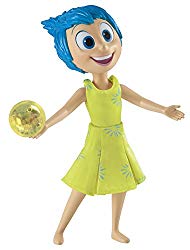
![]() Touch each item. Hold it in your hands. How do you feel? Do you get the warm fuzzies? If so, keep it. If you feel tired or feel nothing, get rid of it.
Touch each item. Hold it in your hands. How do you feel? Do you get the warm fuzzies? If so, keep it. If you feel tired or feel nothing, get rid of it.
Appreciate the items that have served you well, even if their service was just to teach you what you don’t want. If the items are still in good condition, allow them to move on and serve someone else now.
If you’re having trouble figuring out what joy feels like, try a slightly different approach. Instead of picking up each item at random to see whether it sparks anything inside you, start with your favorite three items. Pick up each one and think about how it makes you feel. Use this as a benchmark for comparison with the rest of the pile.
Cherish the items that spark joy and treat them well.
You may discover that only 10% of your items give you joy, or maybe it’s 75%. Whatever it is, release the rest. Donate them if possible or throw them out. They’re not doing you any good any longer.
Tricky Exceptions
You will have trouble discarding some of the items that don’t spark joy. Here’s why.
-
It Might Come In Handy
- Try to throw it away. You probably have something else that can serve the same purpose in a pinch.
- Most instruction manuals are never opened and if truly needed can be found online.
- If you still can’t bring yourself to get rid of it, then keep it with confidence and appreciate its utility.
- If you later change your mind and realize you don’t need it, discard it then.
- In the future, before acquiring anything-even if it’s truly utilitarian-make sure you find joy in at least some aspect of it. You may love the simplicity, the color, the design, how it feels in your hand, or what it allows you to do or create.
-
I Really Do Need It
- Items such as contracts, ceremonial clothing, and family heirlooms may not bring you instant joy, but discarding them will cause you pain from hassle or family disapproval. Keep them and appreciate the peace they offer.
- When they’re no longer needed, discard them.
- If someone else does find joy in them, allow that person to assume their care.
-
It Brings Me Joy, But I’ll Never Wear/Use It Again
- If you truly love a dress or costume from your past but don’t foresee having another appropriate occasion to wear it in the future, wear it around the house. Who cares what anyone else thinks if it makes you happy and isn’t hurting anyone?
- If you try it on and realize it truly is ridiculous, you’ll be able to get rid of it without hesitation.
- If it’s uncomfortable or doesn’t fit but you still love it, make it into something useful or decorative. Turn that old t-shirt into a pillowcase, a stuffed animal, or the lining for a drawer or basket.
- If you have a stack of postcards that you’ll never send but you love the pictures, use them to decorate your closet or line your drawers. You can do the same with your children’s artwork that has overflowed its normal display area.
- If you have a group of small things, let them escape from their packaging and make a pretty display of them in a basket where you can truly enjoy them.
- If you have things that are easy to hang-like keychains or necklaces-use them to liven up your clothes hangers.
Store Everything Last
Once you know how much of each category you want to keep, finding a place for it will be simpler. And now that it’s sorted, keep it all together. Put it in an area that makes sense to you and try to keep like with like.
For example, even though dishes, silverware, and appliances all belong in the kitchen, storing each group in a different cupboard will result in a more harmonious feel to the room.
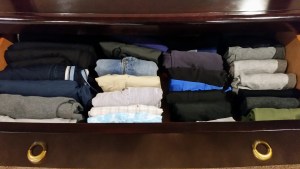 Keep your spaces at 90% capacity. Once you’ve eliminated what you don’t need and what doesn’t give you joy, you can savor having a little extra breathing room. But leaving oodles of extra space will only tempt you to buy more things you don’t need.
Keep your spaces at 90% capacity. Once you’ve eliminated what you don’t need and what doesn’t give you joy, you can savor having a little extra breathing room. But leaving oodles of extra space will only tempt you to buy more things you don’t need.
Finally, within each category make sure your largest items are on the left and that they get progressively smaller and lighter as you move to the right. Dark colors should also be toward the left or the back with lighter colors toward the front or the right.
Four Principles of Storage
-
Fold It Like Origami*
- Fold anything soft and pliable like thin clothes, linens, and bags. This removes air to reduce volume.
- Create a long rectangle that’s as wide as the row you want to make. Fold sleeves, ruffles, or straps toward the center so they’re in the footprint of this rectangle. Then, fold the rectangle almost in half, and fold again or roll the rest.
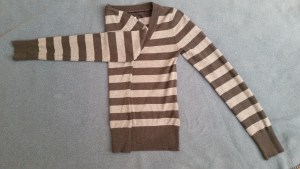
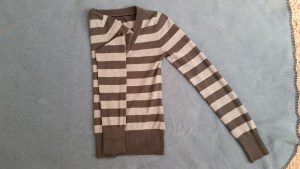
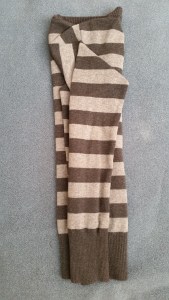
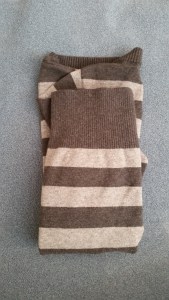
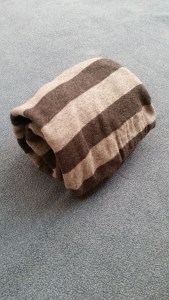
- The finished product should be able to stand on its own or with minimal support from the items around it.
- Socks, underwear, and gauzy fabrics will need a bit more support, so pack them together a little tighter than the rest of your items and/or put them in a box within the drawer.
- Folding this way actually causes fewer wrinkles because items aren’t squished by the rest of the stack on top of them.
- Folding items individually rather than stacking them also makes them much easier to see.
-
Stand It Upright
- If something can stand on its own without falling over, then keep it upright.
- This works well with purses and office supplies.
- Some items are better off hanging than standing on their own.
- It helps take advantage of a space’s height and also allows for easy visibility.
-
Store in One Spot
- If you share a space with others, designate a separate spot for each person.
- Store the larger items first, then fit smaller items in the remaining spaces.
- Start by using built-in storage space like closets and cupboards.
- Next, use the bookcases and dressers you love.
- You’ll probably be able to get rid of those plastic storage drawers that don’t bring you joy.
-
Divide Storage into Square Compartments
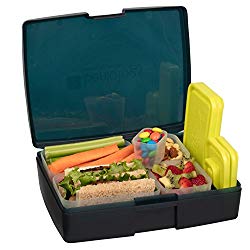
 Think of spaces like a bento box-divide large drawers into smaller squares.
Think of spaces like a bento box-divide large drawers into smaller squares.- Insert shoe boxes, decorative boxes, small dishes, trays, or baskets.
- You can even repurpose those Tupperware bottoms that have lost their lids.
How to Help Others Tidy Up
The most helpful action you can take is to restrain yourself from giving your discarded items to your friends and loved ones. It sounds counterintuitive to give items to strangers or throw them away rather than give them to those you care about, but what you would really be doing is saddling your loved ones with the burden of more stuff that weighs them down.
If you know your sister has always loved a particular purse, painting, or sweater, then go ahead! Give it to her guilt-free. But to give her a carload of clothes she doesn’t need just transfers your clutter to her.
Before you can take other steps to help someone declutter, that person must want help and be ready to change the habit. If you force someone to tidy against her will, she will rebound and your efforts will be wasted.
For now, focus on decluttering your own space and setting a shining example. Your influence may rub off on those around you, and even if it doesn’t, you will still experience joy and freedom.
Surprise Benefits of Tidying
Once your belongings and home are tidy and joyful, you’ll find that the rest of your life naturally becomes less cluttered. Your priorities sharpen and your relationships improve. Life becomes simpler and more peaceful.
Get started today! What do you have to lose?
*The drawings in Spark Joy beautifully illustrate Kondo’s methods and are the main improvement over her previous book. I highly recommend borrowing a copy to see them for yourself.
Have you had success or struggles with decluttering? What did you get rid of that made the biggest difference in your life? Let me know in the comments.
This post contains affiliate links. Learn more here.


Comments 12
We are working to de-clutter now with the eventual downsize of our house coming in the next few years. We just watched a neighbor decide to move and she emptied most of her house into a big dumpster. I am sure there are people who would have taken some of her items is she donated them. My husband and I try to work together on one room - and we try to do one a week. It doesn’t always happen but incremental progress is better than no progress!
Author
Vicki, yes, it’s a lot to tackle all at once, but it’s so much better to do it now than to move stuff and then get rid of it. You’re a smart lady!
I love that this post teaches minimalism. Minimalism can create simplicity with which to make faster and more efficient decisions that Vicki above highlights in one of her blog posts!
Author
Thanks! You’re exactly right-it is much easier to make decisions when you have fewer choices. An emptier closet actually makes it easier to find something to wear.
Great summary and tips from the book. I followed many of the tips from the book, but can’t get the folding to stick. It worked for about a month. We’ve been pretty good at decluttering over the past 7-8 years or so. Some say my house is bare, and I don’t have many things sitting on flat surfaces, which is why it may seem bare to some. But I do keep those things that bring me joy and cleaning doesn’t take much time at all!
Author
Amanda, I love having flat surfaces mostly bare too. It makes dusting sooo much more pleasant and quick.
I’m very lucky that my wife is so good at organising. The amount of money you save (not buying stuff, and on a cost per square foot of storing stuff you don’t use) is huge. I love all these tips, particularly folding. I’m really bad at folding.
Tristan
Author
Hi Tristan, your points are very true. I also like that it limits decisions and prevents analysis paralysis around “What should I wear?” and “What should I pack?” I love items that serve multiple purposes so I have to think even less.
You provided so many great tips for becoming a minimalist. I love your idea of taking pictures before and after. Some categories are easier to de-clutter than others for me and I feel as though I haven’t made a lot of progress in certain categories but pictures would help show the overall outcome. I think your post will inspire lots of people to get started by breaking it down so simply. I hope everyone joins the minimalist movement and is no longer burdened by “things”.
Author
I agree, Jennifer, and you’re probably doing much better than you give yourself credit for. Yay you! Every little bit is progress. And yes, we (and the planet) could all benefit from having less stuff!
This is such a killer recap, and I TOTALLY needed it - I read the book for the first time about a year ago, did the whole “get rid of ALL THE THINGS” process, but am starting to slide back into my old ways. At the very least, I’ve almost entirely abandoned the folding process, haha. I think it’s about time I did another major tidying sesh!
Author
Thanks for your kind words, and good luck with your decluttering. It makes a home seem so calm and peaceful when it isn’t too full. Folding is fun too, though my husband feels like as long as his clothes fit in the drawer AND the drawer will still close then it’s a success, even if they’re in a giant glob. You’ll figure out what works best for you!